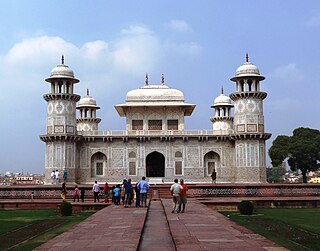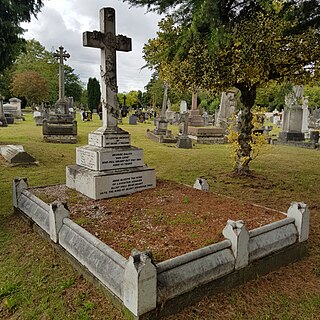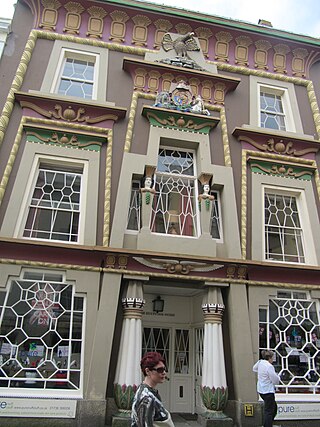Related Research Articles

A cemetery, burial ground, gravesite, graveyard, or a green space called a memorial park, is a place where the remains of dead people are buried or otherwise interred. The word cemetery implies that the land is specifically designated as a burial ground and originally applied to the Roman catacombs. The term graveyard is often used interchangeably with cemetery, but a graveyard primarily refers to a burial ground within a churchyard.

A tomb or sepulcher is a repository for the remains of the dead. It is generally any structurally enclosed interment space or burial chamber, of varying sizes. Placing a corpse into a tomb can be called immurement, although this word mainly means entombing people alive, and is a method of final disposition, as an alternative to cremation or burial.

Highgate Cemetery is a place of burial in north London, England, designed by architect Stephen Geary. There are approximately 170,000 people buried in around 53,000 graves across the West and East sides. Highgate Cemetery is notable both for some of the people buried there as well as for its de facto status as a nature reserve. The Cemetery is designated Grade I on the Register of Historic Parks and Gardens.

Kensal Green Cemetery is a cemetery in the Kensal Green area of North Kensington in the Royal Borough of Kensington and Chelsea and the London Borough of Hammersmith and Fulham in London, England. Inspired by Père Lachaise Cemetery in Paris, it was founded by the barrister George Frederick Carden. The cemetery opened in 1833 and comprises 72 acres (29 ha) of grounds, including two conservation areas, adjoining a canal. The cemetery is home to at least 33 species of bird and other wildlife. This distinctive cemetery has memorials ranging from large mausoleums housing the rich and famous to many distinctive smaller graves and includes special areas dedicated to the very young. It has three chapels and serves all faiths. It is one of the Magnificent Seven cemeteries in London.

The London Necropolis Company (LNC), formally the London Necropolis & National Mausoleum Company until 1927, was a cemetery operator established by Act of Parliament in 1852 in reaction to the crisis caused by the closure of London's graveyards in 1851. The LNC intended to establish a single cemetery large enough to accommodate all of London's future burials in perpetuity. The company's founders recognised that the recently invented technology of the railway provided the ability to conduct burials far from populated areas, mitigating concerns over public health risks from living near burial sites. Accordingly, the company bought a very large tract of land in Brookwood, Surrey, around 25 miles (40 km) from London, and converted a portion of it into Brookwood Cemetery. A dedicated railway line, the London Necropolis Railway, linked the new cemetery to the city.

Brookwood Cemetery, also known as the London Necropolis, is a burial ground in Brookwood, Surrey, England. It is the largest cemetery in the United Kingdom and one of the largest in Europe. The cemetery is listed a Grade I site in the Register of Historic Parks and Gardens.

West Norwood Cemetery is a 40-acre (16 ha) rural cemetery in West Norwood in London, England. It was also known as the South Metropolitan Cemetery. One of the first private landscaped cemeteries in London, it is one of the "Magnificent Seven" cemeteries of London, and is a site of major historical, architectural and ecological interest.

The Magnificent Seven is an informal term applied to seven large private cemeteries in London. These are Kensal Green Cemetery, West Norwood Cemetery, Highgate Cemetery, Abney Park Cemetery, Brompton Cemetery, Nunhead Cemetery, and Tower Hamlets Cemetery. They were established in the 19th century to alleviate overcrowding in existing parish burial grounds as London’s population grew during the Victorian era. In 1981, the architectural historian Hugh Meller dubbed the group of cemeteries "The Magnificent Seven" after the 1960 western film of the same name.

London Necropolis railway station was the terminus at Waterloo, London, of the London Necropolis Railway. The London Necropolis Railway was opened in 1854 as a reaction to severe overcrowding in London's existing graveyards and cemeteries. It aimed to use the recently developed technology of the railway to move as many burials as possible to the newly built Brookwood Cemetery in Brookwood, Surrey. This location was within easy travelling distance of London, but distant enough for the dead not to pose any risk to public hygiene. There were two locations for the station; the first was in operation from 1854 to 1902, the second from 1902 to 1941.

The Layer Pyramid is a ruined step pyramid dating to the 3rd Dynasty of Egypt and located in the necropolis of Zawyet El Aryan. Its ownership is uncertain and may be attributable to pharaoh Khaba. The pyramid architecture, however, is very similar to that of the Buried Pyramid of king Sekhemkhet and for this reason is firmly datable to the 3rd Dynasty.

William Hosking was an English writer, lecturer, and architect who had an important influence on the growth and development of London in Victorian times. He became the first Professor of Architecture at King's College London, and associated this discipline in a scholarly fashion with interests in town planning, civil engineering, history and antiquities.

A rural cemetery or garden cemetery is a style of cemetery that became popular in the United States and Europe in the mid-19th century due to the overcrowding and health concerns of urban cemeteries. They were typically built 1–5 mi (1.6–8.0 km) outside of the city, far enough to be separated from the city, but close enough for visitors. They often contain elaborate monuments, memorials, and mausoleums in a landscaped park-like setting.
The Abney Park Temple Lodges are gatehouses to Abney Park Cemetery designed by William Hosking, to Abney Park in the London Borough of Hackney. The lodges are composed mainly of stone building materials and designed in an Egyptian Revival style, which was unusual for the time period of which the lodges were conceptualized. Augustus W N Pugin was famously against the design of the lodges due to them being non-european despite public fascination of Egyptology at the time.

Lambeth Cemetery is a cemetery in Tooting, in the London Borough of Wandsworth. It is one of three cemeteries owned by Lambeth London Borough Council, the others being West Norwood Cemetery and Streatham Cemetery.

A necropolis is a large, designed cemetery with elaborate tomb monuments. The name stems from the Ancient Greek νεκρόπολις nekropolis.

The London Necropolis Railway was a railway line opened in November 1854 by the London Necropolis Company (LNC), to carry corpses and mourners between London and the LNC's newly opened Brookwood Cemetery, 23 miles (37 km) southwest of London in Brookwood, Surrey. At the time the largest cemetery in the world, Brookwood Cemetery was designed to be large enough to accommodate all the deaths in London for centuries to come, and the LNC hoped to gain a monopoly on London's burial industry. The cemetery had intentionally been built far enough from London so as never to be affected by urban growth and was dependent on the recently invented railway to connect it to the city.

The two Camberwell cemeteries are close to one another in Honor Oak, south London, England. Both have noteworthy burials and architecture, and they are an important source of socioeconomic data in recording the historical growth and changing demography in the community for the Southwark area since 1855.
George Frederick Carden was an English barrister, magazine editor and businessman, credited with the development of the garden cemetery movement in Britain and the foundation of London's pioneering example: Kensal Green Cemetery.

Egyptian Revival architecture in the British Isles is a survey of motifs derived from Ancient Egyptian sources occurring as an architectural style. Egyptian Revival architecture is comparatively rare in the British Isles. Obelisks start appearing in the 17th century, mainly as decorative features on buildings and by the 18th century they started to be used in some numbers as funerary or commemorative monuments. In the later 18th century, mausoleums started to be built based on pyramids, and sphinxes were used as decorative features associated with monuments or mounted on gate piers. The pylon, a doorway feature with spreading jambs which support a lintel, also started to be used and became popular with architects.

Meath Gardens is a 4.1642 hectares park in Bethnal Green in the London Borough of Tower Hamlets in East London, England, and opened to the public in 1894. Before it became a park, it was the Victoria Park Cemetery.
References
- ↑ Kriston Capps (9 March 2015). "Now More Than Ever, London Needs a 'Death Pyramid'". Bloomberg.com. Citylab.
- ↑ "The landmark buildings that never were". BBC News. 24 July 2012.
- 1 2 Penny Magazine of the Society for the Diffusion of Useful Knowledge. C. Knight & Company. 1834.
- 1 2 Loudon, John Claudius (1829). The Gardener's Magazine and Register of Rural and Domestic Improvement. Longman, Rees, Orme, Brown and Green. p. 214 . Retrieved 26 October 2018.
Metropolitan Sepulchre.
- ↑ "London's Pyramid of Death: The Most Ambitious Necropolis That Never Was". Medium (from Teatime History). 29 September 2022. Retrieved 13 June 2023.
- ↑ "Now More Than Ever, London Needs a 'Death Pyramid'". Bloomberg News. 9 March 2015. Retrieved 13 June 2023.
Why the city should revive a 19th-century plan for an uptown necropolis, population 5 million.